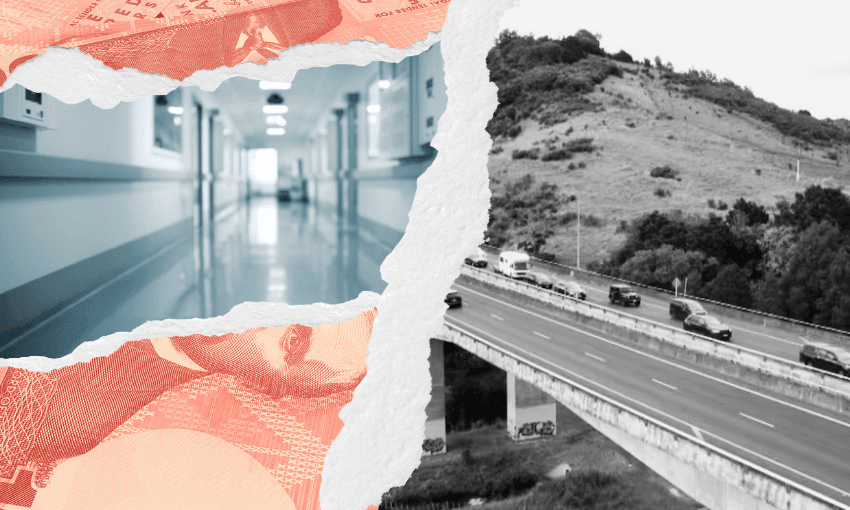From healthcare to roads to education, the user-pays approach has been growing social divides in supposedly egalitarian New Zealand for some time. If things are going to change, a vision that is practical, as well as compelling, is needed.
When thousands of people are signing up for private health insurance even in a cost-of-living crisis, you know something has gone badly awry in our hospitals and GP clinics. Last week, the private insurer Southern Cross Health announced it had gained 15,000 new customers in a year, bringing its membership to more than 955,000.
Nor is this unexpected. At least one iwi has made headlines for buying private health insurance for its staff. And more and more companies offer it as an employee benefit.
But while each move is entirely defensible on an individual basis, especially given the current pressure on public hospitals, the collective danger is obvious: an ever-stronger drift towards something like the American health system, which, centred on private insurance, both wastes unfathomable sums of money and denies healthcare to millions.
And it’s not just health. The government wants to aggressively expand toll roads, even where there may be no decent free alternative. The currently under-construction replacement for the Manawatū Gorge road, a vital conduit in the lower North Island, could cost car drivers $4.30 a trip and trucks $8.60, a potentially unaffordable sum for regular commuters in a low-income region.
Tararua District mayor Tracey Collis says neither of the two “alternative” routes – which include the steep and windy Pahiatua Track – are of an acceptable quality for long-term use. “We don’t want a road that the rich can take and you leave the others for the poor,” she told a recent protest. All the more so given that, once the Gorge road replacement opens, the two alternatives will become her council’s responsibility to maintain – and it won’t be able to afford the bill.
Where there are feasible alternatives, of course, toll roads may not seem so troubling. Driving, after all, uses up resources in a manner that we may want to discourage. But what about the impacts on the poor? Research by the Infrastructure Commission shows road charging takes a bigger chunk out of household budgets for low-income families than for rich ones. Will more poorer households simply stop being able to get from A to B? Or will the untolled roads that serve them sink into greater and greater disrepair? These questions have had remarkably little attention.
For some time, the user-pays approach has been growing and fostering social divides in supposedly egalitarian New Zealand. Compulsory “voluntary” school donations, for instance, have rendered our “free” public education system rather less than free, even if the last Labour government rightly pushed back against that practice. The private fundraising carried out by rich schools vastly outweighs the minimal “equity” funding received by poorer ones. The principal of Porirua College, Ragne Maxwell, told a recent meeting that New Zealand has a “three or four-tier education system”, given the resource disparity between state schools, let alone that between state and private.
In health, we levy GP fees that simply don’t exist in some advanced nations. Cost barriers prevented one in seven New Zealanders from getting care even before the current crisis. The danger now is that such disparities worsen, and harden, and that we sleepwalk still further into a society divided by ability to pay.
How did we get here? Some of our user-pays practices, like GP fees, are long-established, deriving from commercial distrust of collective provision and European settlers’ “rugged individualism”. Other practices are a hangover from the 1980s “Rogernomics” drive, in which state services were regarded less as a collective good to which people are entitled as a mark of their citizenship (even though that is what they really are), and more as a private benefit to the consuming individual.
These tendencies are now being exacerbated by two crises, one imaginary and one of the imagination. The imaginary one concerns the financial state of our government, which we are constantly told is “broke”. In fact it is no such thing: successive governments have saved money in good times and borrowed to get the country through bad times, as is standard practice. Government debt is low, by international and historical standards; one bank economist thinks we could double it without risking a downgrade by ratings agencies.
If we have a problem, it’s that we don’t raise more tax revenue. The European nations with the best public services generate around 40% of GDP in taxes, whereas we take in just 30%. If we taxed at the same rate as the Germans and the Dutch, the New Zealand government would have another $20-$30bn to spend each year fixing up health, education and transport.
No one, then, should fall for the siren song that increased private spending must fill the gap left by the state. Southern Cross is already pushing this line, its chief executive Nick Astwick telling RNZ that private insurance will be part of the solution to the “massive demand” for health as the country ages.
But making people pay for services doesn’t magic money out of thin air; it just shifts spending from the state to the individual. If the individual can’t afford that, the net result is injustice, denial of care and social division. And if it’s less efficient to run a health system via private insurance than tax-funded provision, a country actually ends up getting less healthcare for the same amount of money.
This is emphatically – indeed, disastrously – the case in America. Not only does its health system leave tens of millions of its citizens without adequate care, it wastes vast sums of money, as insurers fight to preserve their profits by denying claims, private hospitals battle with insurers (and patients) over payment, and every part of the system has an incentive to relentlessly overcharge.
The result is that, despite delivering terrible health results overall, America spends, on a per-capita basis, roughly twice as much as its developed-country counterparts. The waste is so vast that it would pay for the insurance costs of the 30 million Americans without cover – or even, most startlingly, the entire budget of Britain’s National Health Service. The lesson for New Zealand is clear: shifting towards a user-pays health system would actually reduce the amount of care the country can provide – as well as making that care more unequal.
So much for the fiscal “crisis”. We do, though, have a crisis of imagination. Why is the public health system in such a state? Partly thanks to the pandemic, of course, and its attendant social strains and public-sector burnout. But partly, too, because Labour decided that the best thing it could do to a public health system in the middle of a once-in-a-century pandemic was to tear it apart structurally and then try to reassemble the pieces.
Leave aside, for the moment, the fact that restructuring is rarely the solution to anything, and think about the paths not taken. Labour could have turbocharged prevention and community care. Or it could have bet the farm on technology: AI, remote tech-assisted care, telehealth. Or it could have taken big steps towards a system with no financial barriers to care whatsoever.
Any of these visions – whatever their respective strengths and weaknesses – would have at least embodied values, beliefs, inspiring ideals. Instead we got a soulless technocracy – one that, judging by current results, doesn’t even work very well. And the same lack of vision can often be seen in Labour’s approach to public services. So it’s no surprise that people acquiesce in, or cannot be motivated to complain much about, a slow drift towards user-pays. In the absence of a more compelling vision, what else would they vote for?
A new vision for public services, in short, is urgently needed. Although there is little evidence that the health minister, Shane Reti, wants to do anything but restore the public system, Act has been vocal about its desire to privatise the whole shebang. The response must be to point out that, yes, health – and other public services – are underfunded. And, yes, we need to reinvigorate the view that public services are fundamentally a collective good: the benefit society derives from having healthy and well-educated people is vastly greater than the benefit to any one individual; and no one should be denied access to those essential goods because of an inability to pay.
But there also has to be a plan for how those services can run differently – better, more efficiently, more in tune with the demands of the 21st century. When core public services run well, it no longer makes sense for people to pay to go private. A vision that is practical, as well as compelling, is needed to ward off the slow drift towards unfair and inefficient user pays. After all, we have seen, over and over in the last few decades, what results when core public services are marketised, when fees and private provision are introduced: a world in which the good life, with all the access to the public realm that it requires, is increasingly reserved for those who can buy it.

